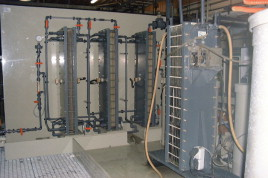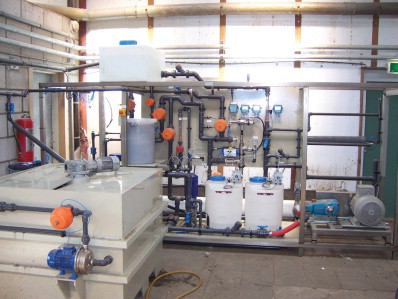

Working in close cooperation, TIM (Tholen Ingenieursbureau Membraantechnologie) and AST (Alternatieve Scheidings Technieken) have, over the last 9 years, developed several innovative recovery applications using membrane technologies. TIM covers the design of the process system and AST manages the control system and the construction of the units. Working together in this way, a special low pressure micro filtration system has been developed that has excellent potential in the area of prefiltration for reverse osmosis.
In many industries waste streams consist of their own products or additives and water. If these can separated successfully then both the product in the waste stream and the water can be reused. A number of successful applications in several branches of industry will be considered.
Low pressure membrane filter (LPMF)
This system consists of a stack of horizontal grooved discs with a diameter of about 1 m. On each side of the disc is a membrane. Between the discs is a distance of about 1 cm to allow the feed. The permeate is drawn through the membrane from the outside to the inside of the disk that is connected to the suction side of a pump. Due to the low fluid velocity the trans-membrane pressure has been minimised to maximum 0.6 bar with still a production of 20-50l/h/m2.
When the membranes get fouled, the entrance to the space between the discs is closed and the water between the discs is drawn via a special device by the suction side of another pump. At the same time, permeate can be drawn through back through the membrane to this special device which is a type of scraper that is rotated radially alongside the membranes.
The cleaning is therefore effected by both back flushing and mechanical scraping very locally at a high flowrate. At each cleaning the scraper is rotated about 2 times with a back flush flow of < 1 l/m2. The great advantage of this system is the low energy consumption, the effective cleaning and the ability to handle high solid loads up to 1 g/l that are present in the feedwater to the RO in pig manure systems.
Membranes in metal treatment
In metal treatment industries many liquid waste streams are produced that contain metals, acid or lye. As an example, a combined waste treatment system used in an aluminium anodising line that had to recover the majority of the waste was installed in 2000. The anodising bath was a 250 g/l sulphuric acid that must be removed when the aluminium content exceeded 15 g/l. After the bath the rinsing system consisted of a standing bath still with a high concentration of sulphuric acid (> 25 g/l) and a cascade rinsing system .
The water of the most concentrated cascade bath is continuously subjected to reverse osmosis (RO). The permeate of the RO can be used as make-up water in the last cascade bath and the concentrate can be added in the standing rinsing bath that still is diluted while the concentration of the RO concentrate is lower than the concentration in the standing rinsing bath. The water of the standing rinsing bath is continuously treated with electrodialysis, where the concentrate can be led into the process bath due to the high concentration.
The process bath itself is continuously treated with diffusion dialysis, recovering about 35 l/h of 200 g/l sulphuric acid. The only waste stream is 35 l/h of aluminium sulphate with about 50 g/l of free sulphuric acid.
The profit is the recovery of 80 % of the acid and all of the water, preventing a waste stream of about 1500 l/h contaminated water and 35 l/h of high concentrated sulphuric acid, leading to a pay back period of 2–3 years. The main profit, however, is that by using this system the quality of both anodising baths and cascade rinsing baths will remain at a high level resulting in a decrease of 65% of off specs products.
Using membranes with pig manure
Pig manure is an increasing problem in the Netherlands due to a shortage of land to dispose of it and also due to the increasing nitrate levels in the drinking water. Dutch farmers now have to pay up to Euro30 per m3 of manure for disposal.
As a result of this, efficient working treatment technologies minimising their disposal can be very lucrative. Working with farmers, a combined technology has been developed, which first separates the solids (thick fraction) and the fluid (thin fraction). The thick fraction can be composted and used as compost for fertilisation.
The thin fraction first is treated with flocculation, coagulation and flotation to separate the majority of the small solids. The flotate is combined with the thick fraction after dewatering. The remaining fluid is treated in a special low pressure microfiltration system with automatic mechanical cleaning and a two stage reverse osmosis system.
In this system about 70% of the thin fraction is converted into clean water that can be disposed in the sewer or reused elsewhere on the farm. The concentrate can be used as fertilizer in greenhouses. With the present manure disposal prices the pay-back period for this system is around 2–3 years.
Conclusion
Membrane technologies can improve processes in many different kinds of applications/industries varying from waste to food. Both quality and efficiency profit.
The newest developments are in desalting process streams in the dairy and sugar industry.
Contact: TIM Tel: +31 35 693 3222, www.elektrolyse.nl, www.timtholen.nl, info@elektrolyse.nl AST Tel: +31 33 494 5686, www.separatie.nl, info@separatie.nl






